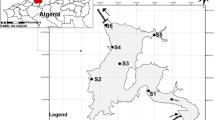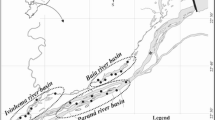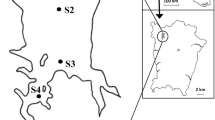Abstract
Submerged hydrophyte vegetation consists of a highly important biotic component of maintaining lake ecosystems towards a “clear water” ecological status. Aquatic macrophytes are well known to play a significant multidimensional role in lakes by competing with phytoplankton growth, stabilising sediment and offering refuge to fishes, macro-invertebrates and littoral zooplankton, amongst others. Zooplanktons that are associated with macrophyte beds, in particular, may act as a positive feedback mechanism that contributes to maintaining a clear-water state. Although there are several studies investigating the relationships between macrophytes and zooplankton in European lakes, few have yet been carried out in Greek lakes. Seasonal field sampling was conducted from spring 2006 to autumn 2008 in four lakes of northwestern Greece. Zooplankton samples were collected from within hydrophyte beds in each lake to estimate their relative abundance and species density. Hydrophyte abundance and composition was recorded on a five-point scale. Moreover, water samples were analysed to determine nutrient and chlorophyll-a concentration. Pearson correlations between zooplankton density and key physicochemical variables were conducted to distinguish significant abiotic variables related with major zooplankton groups. Kruskal–Wallis non-parametric analysis was used to test for significant differences in zooplankton composition and environmental variables amongst the five hydrophyte abundance classes. In addition, Canonical correspondence analysis was used to distinguish possible correlations amongst the macrophyte and zooplankton species. Zooplankton density was significantly higher in dense macrophyte vegetation. Small-sized species (e.g. Rotifera) dominated the zooplankton community, indicating the eutrophic nature of the lakes. Large Cladocera were present in low abundance and were mostly littoral. The current research contributes to a better understanding of relationships between biotic groups in selected Greek lakes.






Similar content being viewed by others
References
Ali, M. M., A. A. Mageed & M. Heikal, 2007. Importance of aquatic macrophyte for invertebrate diversity in large subtropical reservoir. Limnologica 37: 155–169.
APHA, 1992. Standard Methods for the Examination of Water and Wastewater. American Public Health Association, New York.
Arora, J. & N. K. Mehra, 2003. Species diversity of planktonic and epiphytic rotifers in the Backwaters of the Delhi Segment of the Yamuna River, with remarks on new records from India. Zoological Studies 42: 239–247.
Basu, B. K., J. Kalff & B. Pinel-Alloul, 2000. The influence of macrophyte beds on plankton communities and their export from fluvial lakes in the St. Lawrence River. Freshwater Biology 45: 373–382.
Blindow, I., G. Andersson, A. Hageby & S. Johansson, 1993. Long-term pattern of alternative stable states in two shallow eutrophic lakes. Freshwater Biology 30: 159–167.
Blindow, I., A. Hageby, B. M. A. Wagner & G. Andersson, 2000. How important is the crustacean plankton for the maintenance of water clarity in shallow lakes with abundant submerged vegetation? Freshwater Biology 44: 185–197.
Burks, R. L., E. Jeppesen & D. M. Lodge, 2001. Pelagic prey and benthic predators: impact of odonate predation on Daphnia. Journal of the North American Benthological Society 20: 615–628.
Burks, R. L., D. M. Lodge, E. Jeppesen & T. L. Lauridsen, 2002. Diel horizontal migration of zooplankton: costs and benefits of inhabiting the littoral. Freshwater Biology 47: 343–365.
Burks, R. L., G. Mulderij, E. Gross, I. Jones, L. Jacobsen, E. Jeppesen & E. van Donk, 2006. Center stage: the crucial role of macrophytes in regulating trophic interactions in shallow lake wetlands. In Bobbink, R., B. Beltman, J. T. A. Verhoeven & D. F. Whigham (eds), Wetlands: Functioning, Biodiversity Conservation and Restoration. Springer, Berlin: 37–59.
Catsadorakis, G., 1997. The importance of Prespa National Park for breeding and wintering birds. Hydrobiologia 351: 157–174.
Crivelli, A. J., G. Catsadorakis, M. Malakou & E. Rosecchi, 1997. Fish and fisheries of the Prespa lakes. Hydrobiologia 351: 107–126.
De Cáceres, M. & P. Legendre, 2008. Beal’s-smoothing revisited. Oecologia 156: 657–669.
Gianniou, S. K. & V. Z. Antonopoulos, 2007. Evaporation and energy budget in Lake Vegoritis, Greece. Journal of Hydrology 345: 212–223.
Green, J., 2003. Associations of planktonic and periphytic rotifers in a tropical swamp, the Okavango Delta, Southern Africa. Hydrobiologia 490: 197–209.
Iglesias, C., G. Goyenola, N. Mazzeo, M. Meerhoff, E. Rodo & E. Jeppesen, 2007. Horizontal dynamics of zooplankton in subtropical Lake Blanca (Uruguay) hosting multiple zooplankton predators and aquatic plant refuges. Hydrobiologia 584: 174–189.
Jack, J. D. & J. Thorp, 2002. Impacts of fish predation on an Ohio River zooplankton community. Journal of Plankton Research 24(2): 119–127.
Jeppesen, E., J. P. Jensen, M. Søndergaard & T. Lauridsen, 1999. Trophic dynamics in turbid and clear water lakes with special emphasis on the role of zooplankton for water clarity. Hydrobiologia 408(409): 217–231.
Jeppesen, E., M. Søndergaard, M. Søndergaard, K. Christoffersen, J. Theil-Nielsen & K. Jurgens, 2002. Cascading trophic interactions in the littoral zone: an enclosure experiment in shallow Lake Stigsholm, Denmark. Archiv für Hydrobiologie 153: 533–555.
Kagalou, I. & I. Leonardos, 2009. Typology, classification and management issues of Greek lakes: implication of the Water Framework Directive (2000/60/EC). Environmental Monitoring and Assessment 150: 469–484.
Kagalou, I., E. Papastergiadou & I. Leonardos, 2008. Long term changes in the eutrophication process in a shallow Mediterranean lake ecosystem of W. Greece: response after the reduction of external load. Journal of Environmental Management 87: 497–506.
Kuczyńska-Kippen, N. & B. Nagengast, 2003. The impact of the spatial structure of hydromacrophytes on the similarity of rotifera communities (Budzynskie Lake, Poland). Hydrobiologia 506–509: 333–338.
Lauridsen, T., E. Jeppesen, F. Landkildehus & M. Søndergaard, 2001. Horizontal distribution of cladocerans in arctic Greenland—impact of macrophytes and fish. Hydrobiologia 442: 107–116.
Mastrantuono, L. & T. Mancinelli, 2005. Littoral invertebrates associated with aquatic plants and bio assessment of ecological status in Lake Bracciano (Central Italy). Journal of Limnology 64(1): 43–53.
Michaloudi, E. & M. Kostecka, 2004. Zooplankton of Lake Koroneia (Macedonia, Greece). Biologia (Bratislava) 59(2): 165–172.
Michaloudi, E., M. Zarfdjian & P. S. Economidis, 1997. The zooplankton of lake Mikri Prespa. Hydrobiologia 351: 77–94.
Moustaka-Gouni, M., E. Vardaka, E. Michaloudi, K. A. Kormas, E. Tryfon, H. Michalatou, S. Gkelis & T. Lanaras, 2006. Plankton food web structure in a eutrophic polymictic lake with a history of toxic cyanobacterial blooms. Limnology and Oceanography 51((1 Part 2)): 715–727.
Moustaka-Gouni, M., E. Vardaka & E. Tryfon, 2007. Phytoplankton species succession in a shallow Mediterranean lake (L. Kastoria, Greece): steady-state dominance of Limnothrix redekei, Microcystis aeruginosa and Cylindrospermopsis raciborskii. Hydrobiologia 575: 129–140.
Nurminen, L. & J. J. Horppila, 2002. A diurnal study on the distribution of filter feeding zooplankton: effect of emergent macrophytes pH and lake trophy. Aquatic Science 64: 198–206.
Papastergiadou, E., M. Agami & Y. Waisel, 2002. Restoration of aquatic vegetation in Mediterranean wetlands. In Zalidis, G., T. Crisman & P. A. Gerakis (eds), Restoration of Mediterranean Wetlands. Medwet Publications, France.: 47–69.
Papastergiadou, E., I. Kagalou, K. Stefanidis, A. Retalis & I. Leonardos, 2010. Effects of anthropogenic influences on the trophic state, land uses and aquatic vegetation in a shallow Mediterranean lake: implications for restoration. Water Resources Management 24: 415–435.
Scheffer, M., 1998. Community Dynamics of Shallow Lakes. Chapman & Hall, London.
Stefanidis, K. & E. Papastergiadou, 2007. Aquatic vegetation and related abiotic environment in a shallow urban lake of Greece. Belgian Journal of Botany 140(1): 25–38.
Tolonen, K. T., H. Hämäläinen, I. J. Holopainen & J. Karjalainen, 2001. Influences of habitat type and environmental variables on littoral macroinvertebrates communities in a large lake system. Archiv für Hydrobiologie 152: 39–67.
Vardaka, E., M. Moustaka-Gouni, C. Cook & T. Lanaras, 2005. Cyanobacteria blooms and water quality in Greek waterbodies. Journal of Applied Phycology 17: 391–401.
Walseng, B., D. O. Hessen, G. Halvorsen & A. K. Schartau, 2006. Major contribution from littoral crustaceans to zooplankton species richness in lakes. Limnology and Oceanography 51(6): 2600–2616.
Zacharias, I., I. Berthachas, N. Skoulikidis & T. Koussouris, 2002. Greek lakes: limnological overview. Lakes and Reservoirs: Research and Management 7: 55–62.
Acknowledgements
This research was funded by grants from the State Scholarships Foundation Research of Greek Ministry of Education. We wish to thank Dr. Natalia Kuczyńska-Kippen, (The University of Adam Mickiewicz, Poland) for his invaluable guidance and counsel on assessing and identifying zooplankton samples, as well as Anna Basińska and Kasper Świdnicki for their valuable advices regarding the identification of zooplankton species. We are also grateful to Prof. Dr Arnold Pieterse and two anonymous referees for their helpful and valuable suggestions on the earlier version of the manuscript.
Author information
Authors and Affiliations
Corresponding author
Additional information
Guest editors: A. Pieterse, S. Hellsten, J. Newman, J. Caffrey, F. Ecke, T. Ferreira, B. Gopal, J. Haury, G. Janauer, T. Kairesalo, A. Kanninen, K. Karttunen, J. Sarvala, K. Szoszkiewicz, H. Toivonen, L. Triest, P. Uotila, N. Willby / Aquatic Invasions and Relation to Environmental Changes: Proceedings of the 12th International Symposium on Aquatic Weeds, European Weed Research Society
An erratum to this article is available at http://dx.doi.org/10.1007/s10750-017-3090-x.
Electronic supplementary material
Below is the link to the electronic supplementary material.
Rights and permissions
About this article
Cite this article
Stefanidis, K., Papastergiadou, E. Influence of hydrophyte abundance on the spatial distribution of zooplankton in selected lakes in Greece. Hydrobiologia 656, 55–65 (2010). https://doi.org/10.1007/s10750-010-0435-0
Published:
Issue Date:
DOI: https://doi.org/10.1007/s10750-010-0435-0




